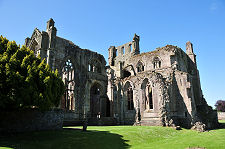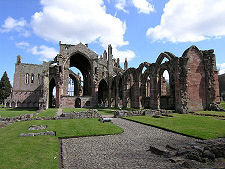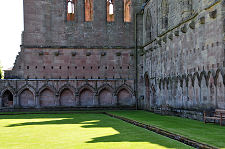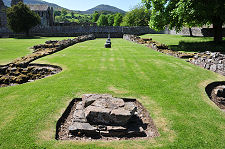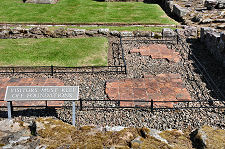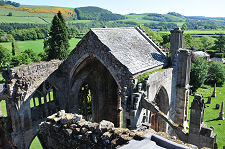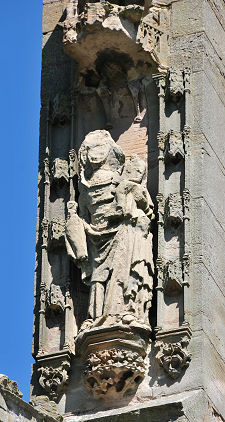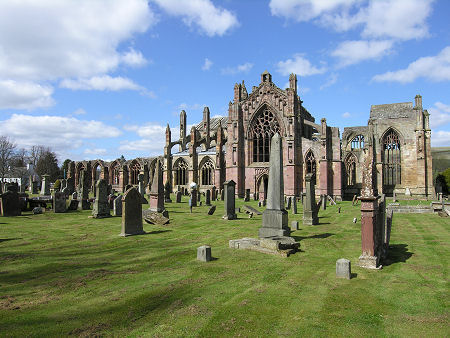 Melrose Abbey from the South |
The story of Melrose Abbey extends back to some time before 650AD, though its origins are at a place now known as Old Melrose (called Mailros at the time) which stands in a loop in the River Tweed some 2.5 miles east of the monastery you see today. It was here that St Aidan of Lindisfarne established a monastery, to which he brought monks from St Columba's monastery on Iona. The most notable monk to emerge from this first monastery was St Cuthbert. He became prior of the monastery at Old Melrose in 664, and six years later he was appointed prior of Lindisfarne.
The abbey at Mailros, or Old Melrose, was destroyed by Kenneth Mac Alpin, King of the Scots, in 839. The site was later used as a place of retreat and it is possible that a church continued in use there for centuries after the monastery's destruction.
In 1136 King David I asked Cistercian monks from Rievaulx Abbey in North Yorkshire to found an abbey in Melrose. David intended this to be on the site of St Aidan's earlier monastery at Mailros, suggesting the location was still seen as having religious significance. The Cistercians, however, needed good farming land within which to place their abbey, and appear to have been successful in their negotiations with the king. The end result was the establishment of a monastery a little further west at a place then called Little Fordell. Today this is known as Melrose. (Continues below image...)
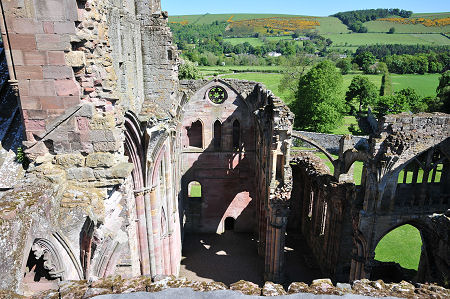 A View of the Interior from the Top of the South Transept |
Melrose Abbey was first staffed by an abbot and 12 monks from Rievaulx, who set to work constructing the abbey buildings. The east end of the abbey church would have been built first, and a service of dedication for it took place on 28 June 1146. Other buildings in the complex were slowly constructed over a period of at least another 50 years. The best known monk at Melrose during this period was Jocelin, who rose to become the 4th Abbot of Melrose Abbey in 1170. In 1150, only 14 years after its own foundation, Melrose was asked by David I to found a daughter house at Kinloss Abbey in Moray.
The abbey built during latter half of the 1100s seems to have been considerably smaller than the one you see today, with the abbey church drawing inspiration from the original plan of its counterpart at Rievaulx. The basic elements of nave, presbytery and transepts were there, but archeological and historical evidence suggests that it was a very simple structure with, in line with the principles of the Cistercians, very little in the way of adornment.
In 1322 Melrose Abbey and the town that had grown up around it were attacked by the English army of Edward II. Much of the abbey was destroyed and many monks were killed. The subsequent rebuilding was helped greatly by the generosity of Robert the Bruce. This link was later formally recognised when Robert's embalmed heart, encased in lead, was buried at Melrose Abbey. The story goes that while Robert the Bruce's body was buried in Dunfermline Abbey, in line with his wishes, his heart was buried at Melrose Abbey. According to some sources it was first taken in a lead casket on a crusade against the Moors.
In 1385 the Scots invaded northern England to deflect the latter's attentions from France (see our Historical Timeline). This was not a wise move. Richard II of England defeated David II of Scotland and pushed the Scots back as far as Edinburgh, burning down Melrose Abbey as his army passed by.
Over a hundred years of reconstruction followed. Different architectural styles employed at different stages in the reconstruction suggest that the work was begun by the English under Richard II and later continued by the Scots. Building work was still continuing when James IV visited over a century later in 1502 and 1504, and it is thought that the west end of the abbey church may never have been completed to the original plan. This is the only part of the structure whose origins can be traced back to the original abbey church built in the 1100s.
Whether or not the building was actually completed, what was built was magnificent enough, as you can see for yourself: except for the wall at the west end of the nave, virtually everything on view today can be dated back to this last round of reconstruction.
English armies returned to southern Scotland in 1544 and 1545, this time in support of efforts by Henry VIII to persuade the Scots to betroth the infant Mary Queen of Scots to his son. Melrose and its abbey were both badly damaged. By 1556 the remaining monks complained that unless repairs were carried out, the abbey would not be able to continue to function over the approaching winter.
In 1560 the monks at Melrose Abbey embraced the Reformation in an effort to ensure their personal security, but they did so within a badly damaged and rapidly deteriorating complex of buildings. The last resident monk died at Melrose in about 1590, by which time the abbey was already being used as a quarry for cut stone (not to mention valuable lead, glass and wood) by local landowners.
In 1610 part of the central portion of the nave of the Abbey Church was converted into a parish church for Melrose, with end walls and windows inserted into the existing structure. This continued in use until replaced by a new church elsewhere in Melrose in 1810.
Melrose Abbey today comprises the fairly complete ruins of the truly remarkable abbey church with, to their north, the foundations of the extensive ranges of buildings which once comprised the rest of the abbey. At the eastern end of the complex these extend through the Lay Brothers' Range as far as the millstream constructed to divert water from the River Tweed.
At the north end of the site is the Commendator's House. The commendator was an appointed lay administrator, in latter years usually someone with powerful friends or relations wanting to benefit from the income attached to the post. The house dates back to the 1400s, but was converted into a dwelling in 1590. Today it houses an excellent museum which lays claim to having the largest collection of medieval artefacts on display anywhere in Scotland. You can see our separate feature about the Commendator's House Museum here.
 Melrose Abbey from the South-East |

|
|
|
Visitor InformationView Location on MapSTB 5 Star Historic Attraction. Tel: 01896 822562. Post Code: TD6 9LG Grid Ref: NT 548 341 www.historicenvironment.scot HES: Abbey Web Page Opening Hours Admission Accessibility What3Words Location: ///prices.pegs.seats |
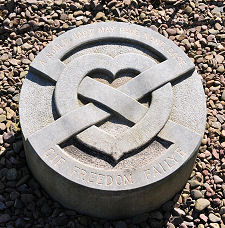 Burial Place of Robert the Bruce's Heart |
 Abbey Interior, Looking West |
 Abbey Interior, Looking South |
 The Crossing |
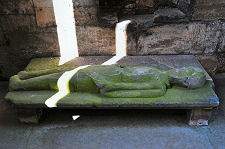 Stone Effigy |
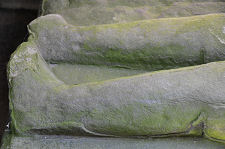 The Effigy's Feet |
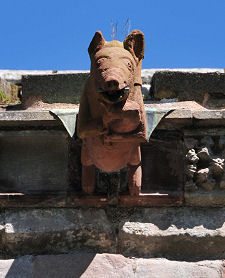 Bagpipe Playing Pig |
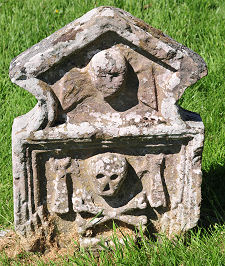 Symbols of Mortality |
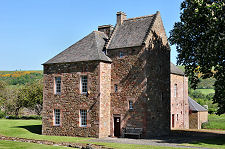 The Commendator's House |
 Commendator's House Museum |
 Reception and Shop |
